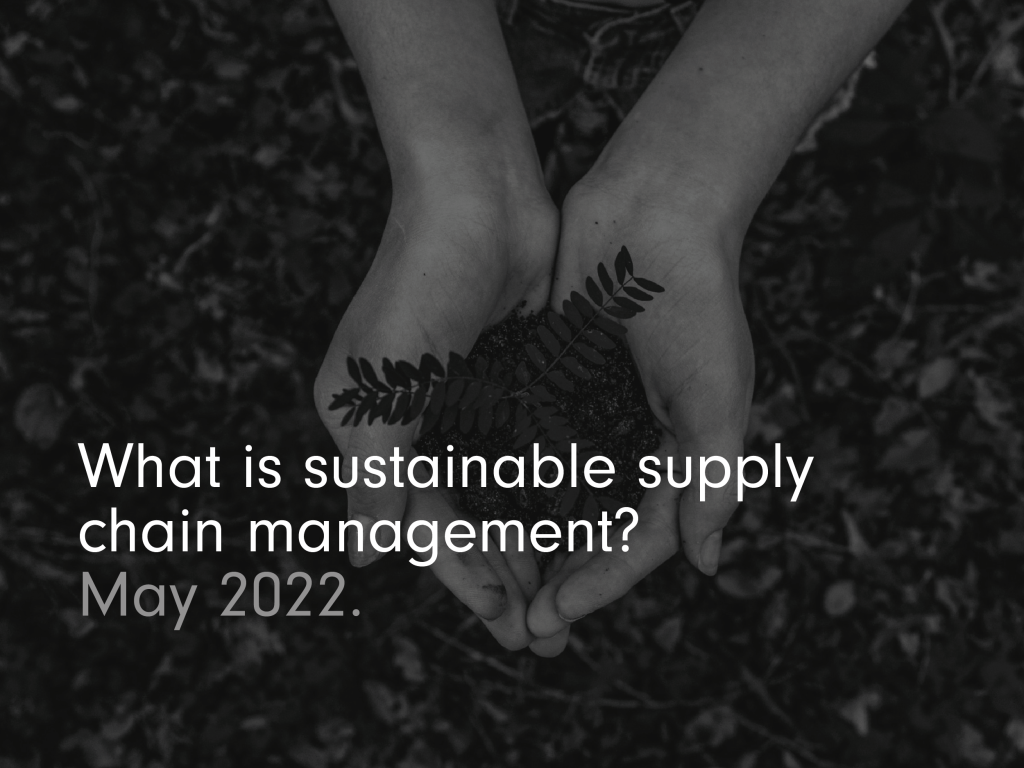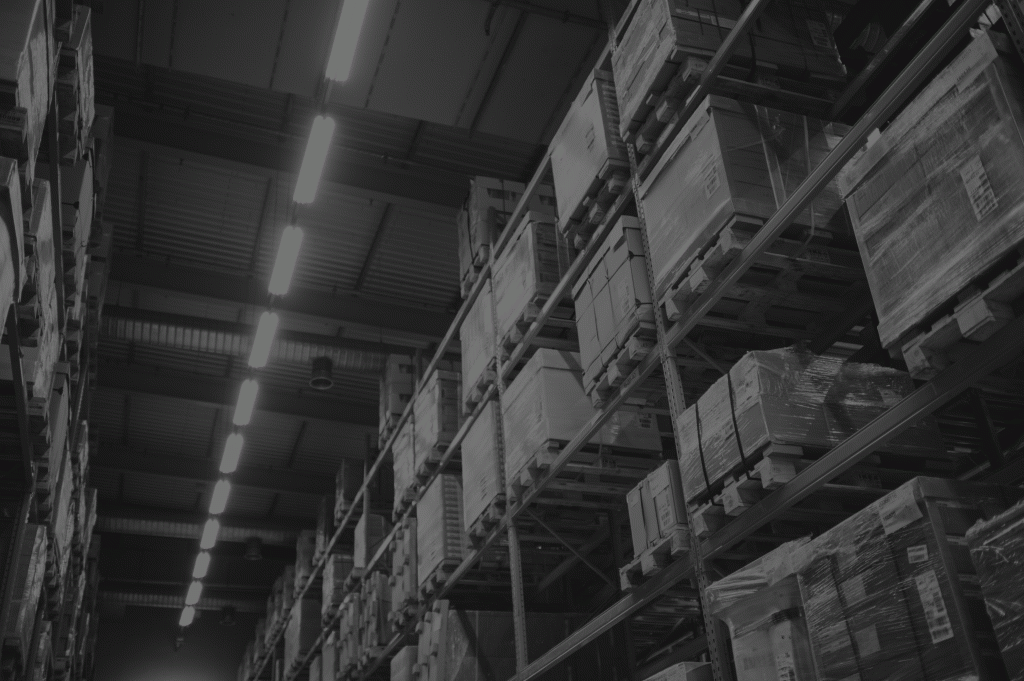What is sustainable supply chain management?

The supply chain is a vital part of the modern world, but it could be costing the environment in the long term. In fact, the supply chain accounts for more than 80% of consumer companies’ greenhouse gas emissions, and more than 90% of their overall environmental impact (McKinsey).
It’s only natural that the supply chain is a large contributor to a company’s carbon footprint. After all, it makes up a vast proportion of business operations. However, in a time when climate change is on everyone’s minds, customers and investors are putting more pressure on businesses to reduce their environmental and social impact. And, as the supply chain is the biggest contributor to environmental and ethical issues, it’s where we can make the most significant impact.
By making a few changes, a company can ensure the sustainability of its supply chain. Here, we’ll be going through everything you need to know about sustainable supply chain management, including:
What is supply chain sustainability?

Supply chain sustainability refers to the management of environmental, social, and economic impact throughout the supply chain to ensure it can be maintained over time. This includes factors such as reducing carbon emissions, water usage, and deforestation and ensuring fair labour practices and human rights.
While the supply chain has traditionally focussed on factors such as time management and costs, sustainable supply chain management looks at how these aspects can be handled with as little disruption as possible.
The three elements of supply chain sustainability
A sustainable supply chain focuses on three key metrics to help reduce the environmental, social, and economic (also called financial or governance) impact of its operations. By measuring these three factors, you can track your overall sustainability performance.
Environmental
The environmental impact of your supply chain refers to any aspect that directly or indirectly impacts the planet. This includes factors such as water and electricity usage, carbon emissions, and waste. Any supply chain can benefit from monitoring its environmental impact, but the factors you place importance on can differ depending on where you feel needs the most improvement.
This is where your KPIs come into play. For example, if one of your goals is to reduce your fuel consumption, you may wish to use a transport management system (TMS) to monitor delivery routes and times. With this information, you can take steps to optimise this sector of your business and reduce your carbon emissions. You can find out more information on optimising delivery routes below.
Social
The social impact of your supply chain means ensuring everyone is treated fairly at every stage of your business according to human rights laws and fair labour practices. This is not just limited to your employees, but also includes your suppliers, customers, and your local community. For example, working with reputable vendors who uphold fair labour and environmental practices is a vital step to ensuring the ethical responsibility of your business. Some companies also choose to give back to their local community by donating to charities or volunteering for local causes.
Economic
Financial growth is key to a sustainable supply chain, but it’s important that businesses can ensure economic development without impacting their local environment or culture. This not only includes factors such as efficient financial planning and risk management, but also encompasses responsibilities like payment and pensions, insurance, and financial laws and regulations.
Automation is a key part of ensuring a sustainable and profitable supply chain. Tools such as warehouse management systems (WMS) and enterprise resource planning software (ERP) can help keep the financial aspects of your business in check. Software like this can improve transparency and accountability across the supply chain. WMS and ERP can also make the procurement process much more efficient, boosting productivity and reducing waste, and therefore cutting costs overall.
The importance of sustainability in the supply chain

As the supply chain is such a major contributor to greenhouse gas emissions it’s vital to take steps to become more sustainable. Not only can a sustainable supply chain be better for the environment and for the community, but it can open up more opportunities for your business. The benefits of supply chain sustainability include:
Reduced operating costs
There’s often a misconception that going green is costly but implementing sustainable practices can actually help save you money in the long term. Whether it’s by lowering waste or reducing energy usage, many factors of a sustainable supply chain can help lower your operating costs. Granted that making the move to a greener supply chain may be more costly upfront, for example when implementing new software or making changes to your processes, but these changes can benefit your bottom line long term. A sustainable supply chain strategy can save between 5 to 10% of your overall costs (McKinsey).
Improved reputation and customer loyalty
Having an eco-friendly and ethical company image can help improve your reputation in your industry and with customers. Now more than ever, customers want to shop with businesses that align with their personal values. In fact, 34% of all UK consumers said that they would choose brands that have environmentally friendly practices, while 30% would choose brands that have ethical values (Deloitte).
People want to know that their purchasing decisions are doing good for the planet and for social causes, and will boycott brands when they’re not ethical. Working with unethical suppliers can put your brand at risk. You could see issues such as reputational damage and high staff turnover among others. Switching to ethical suppliers and adopting sustainable practices yourself can ensure your business is around for the long run. Customers and vendors will feel good about working with you if your principles align with their own, which can boost brand loyalty. Better yet, adopting ethical and eco-friendly practices can put you ahead of companies that don’t, which could win you new customers and clients.
Better preparation for future disruptions
Adopting a sustainable supply chain can also help better prepare your business for future changes. Sustainability can sometimes require abstract thinking and companies need to be flexible in order to embrace their new ways of working. Being able to do this effectively now can help prepare you for future supply chain disruptions.
How to improve supply chain sustainability

So how can you make your supply chain more sustainable? There are many practices you can adopt to make your supply chain green and more ethical, and the ones you focus on may depend entirely on your sector, business size, and company objectives.
For example, some businesses may benefit from large changes to warehouse infrastructure, like adding new insulation, retrofitting heating and air conditioning systems, or implementing new renewable energy methods. Smaller businesses with a relatively low warehouse footprint may benefit from more minor changes such as automation or waste reduction.
Below are just some of the ways you can incorporate sustainability into your supply chain management. For more information, be sure to take a look at our guide to making your warehouse more eco-friendly, which includes small changes you can make to your everyday operations to boost your warehouse sustainability.
Reduce waste.
Both packaging and product waste can be a major problem in the supply chain, particularly in the food and beverage and pharmaceutical industries. Many of these companies distribute products wrapped in single-use plastics, such as plastic bottles and packets. This sector may also find that product waste is a problem due to perishable stock. Our research revealed that 4.8 million tonnes of food are wasted in the UK supply chain every year. That’s enough to feed the whole of the UK for 39 days.
If you know waste is an issue in your supply chain, then your next step is to look at ways to reduce your warehouse waste. For example, instead of using single-use and plastic packaging, consider working with suppliers to make use of recyclable and compostable alternatives. For more information on sustainable packaging, be sure to read our guide to reducing single-use plastic in the supply chain.
To reduce product waste, you may want to use a warehouse management system (WMS) to track stock turn and identify products close to their expiry dates. You’ll then be aware of any items that need to be put on promotion or placed in a more prominent area of the warehouse. Monitoring your stock turn also allows you to see which products are selling quickly and which ones are often left sitting on shelves. As a result, you can alter incoming orders to suit the demand and reduce the likelihood of products going to waste.
Go circular.
You may have heard the term “circular economy”, but how does that apply to the supply chain? In circular supply chains, products are disassembled back into their raw materials before being remade into a new item to be sold. An example of this includes taking parts from old computers that are still in working order and repurposing them in new products. Or, melting down plastic to be used in 3D printers. This reduces the reliance on brand new materials and draws away from the traditional linear supply chain — the ‘make, use, and throw away’ version that we’re used to.
By reusing materials, the circular supply chain is not only better for the environment, but it’s more cost-effective too. It also gives you much more control over your processes, as you’re reducing the reliance on external suppliers.
Cut packaging costs.
No matter if you’re using single-use or recyclable options, packaging costs in the warehouse can be substantial — especially in high volume operations. While switching to eco-friendly alternatives is a much more sustainable option, you may find that you’re using too much packaging for certain products. A WMS can help here by reducing the amount of packaging you use and eliminating costly waste.
The system can calculate the best packaging to use for each order, according to its profile. That might be based on weight, size, or other parameters you set. Using the smallest, most apt size of container or box means you don’t despatch a single lipstick packed in an A4 box with a mass of unneeded polystyrene packing chips.
Using the optimum packaging reduces your costs and the environmental impact of your operation.
Reduce the size of your warehouse.
Using a WMS to optimise where and how you store your products in the warehouse will almost certainly reduce the amount of space you require. Using a smaller warehouse results in lower energy consumption because you don’t need to light, heat, and air-condition as large a space. You might therefore benefit from relocating to a smaller warehouse. Or you could instead sub-let some of your space to another company and gain additional revenue at the same time. And if you planned to expand in the future, using a WMS might mean you could carry the additional stock needed without forcing you to move to a larger warehouse.
Lower energy consumption of equipment.
Whether your forklift trucks are powered by electricity, diesel, or LPG/gas, you can reduce how much energy they use and cut your carbon footprint. A WMS optimises movement-intensive operations like putaway and picking so that the routes travelled are minimised. It ensures that operatives are driving fewer miles around the warehouse by finding them the shortest routes to take. A WMS can also employ more advanced methods such as task interleaving, which combines different jobs into a single trip within the warehouse.
With functionality such as directed putaway, your staff won’t be driving up and down the aisles looking for a location to store goods — the WMS system will direct them where to go. Equally, a WMS can optimise picking strategies, using methods like batch picking or zone picking to reduce how far your workers need to drive, again limiting the energy you are expending.
Eliminate paper from the warehouse.
A paper-driven warehouse is costly — in terms of both the money you use on printer ink and paper and the cost to the environment. When you implement computer-based systems such as ERP and WMS, you eliminate the costs and save precious resources. With these tools, your staff use mobile devices that direct them where to go and what to do. Processes are automatically recorded, instead of needing to be entered back into the system, and there’s an accurate trail of actions that isn’t reliant on paper.
A paper-free operation is more efficient, places fewer demands on the environment and will reduce your carbon emissions to give you a more sustainable warehouse.
Streamline your processes and increase productivity.
By automating and optimising processes, a WMS increases the productivity of your warehouse staff. WMS, ERP, and TMS ensures that operations are run efficiently, meaning your operatives can get through more work in less time.
WMS can also pinpoint how and where you can limit the use of material handling systems and equipment. For example, you might be able to combine tasks in such a way that means there are times when conveyors or carousels are idle. Then, you could switch these off during those times, cutting the amount of energy you use.
All the time your warehouse is in operational use you are using power to light it, heat it, and ventilate it. If you can cut the number of shifts per month or reduce the total time that the warehouse is operational, then you will reduce your electricity bill and cut your carbon footprint.
Implement automation.
By employing automation in the warehouse, many operations can substantially reduce the number of people needed on the warehouse floor. Facilities operated by robots and automated systems are known as dark warehouses because they can theoretically be run entirely in the dark.
The automation is directed by the WMS, sometimes alongside a warehouse control system (WCS). With no human operatives to indulge, lighting and heating are not required. This significantly slashes the energy used and reduces the carbon footprint of the warehouse. Better yet, relying on automation for certain tasks can boost your ethical standing. For example, you may want to utilise robots for tasks that may not be as safe for a human worker, such as heavy lifting. Robots can also work longer hours, meaning you can make use of them during busy periods without overstretching your workforce.
Finance is another area you can apply automation and boost your sustainability, ethics, and economic credentials. With an ERP system, you can store all sensitive data in one place with multiple levels of security, complying with GDPR. Not only that, but some tools also have a built-in compliance functionality which ensures that all of your accounting processes adhere to industry regulations and best practices. You can find out more about this in our guide to ERP in the supply chain.
Optimise delivery routes.
Perhaps your logistics process is the area that needs work. It’s possible that you may not be planning your routes as efficiently as you could be, or you may be using more fuel intensive vehicles than you need to, and you’re therefore producing excess emissions.
If this is the case, you might benefit from a transport management system (TMS) which can help you optimise your delivery routes and consume less fuel. Benefits include consolidating journeys, finding the most efficient route, and obtaining proof of delivery. Better yet, it’s all completely paperless.
A good example of TMS in action is our case study with H.N. Nuttall. This food delivery company noticed that they were often overlapping journeys and were using vehicles with a higher weight capacity than was needed. With TMS, they could monitor their routes, plan them better, and even react quickly to any sudden changes.
An added benefit of TMS is that it can improve communication, ensuring end-to-end transparency. With vehicle tracking and proof of delivery, you can ensure visibility and accountability right up to the very last stage of your supply chain.
If you’re not sure whether this is the right solution for you, take a look at our advice for deciding if your business needs a TMS.
Collaborate with ethical suppliers.
Of course, sustainable supply chain management doesn’t fall completely on your warehouse and logistics. Your suppliers also contribute to your supply chain sustainability. Unfortunately, exploitation and malpractice are still common throughout the supply chain, and working with an unethical supplier, even unintentionally, could be bad news for your own business.
Being aware of labour laws and regulations and ensuring your business adheres to them is vital. When working with a supplier, be sure to do your research into their own practices to ensure their values align with your own standards.
Transparency is key here. Making sure that all parties are open throughout every stage is important for ensuring ethical standards are upheld. This extends to your customers too, as they’ll want to know that your product is ethically sourced or manufactured. Being able to map out your supply chain and determine the source and production methods means you can relay this back to the customer with total confidence.
Sustainable supply chain examples

Many large brands have adopted sustainable practices in their supply chain. Below are just some examples of a sustainable supply chain in action.
HP
While it delivers computers all over the world, HP has still managed to incorporate sustainability and ethics into its supply chain. For one, the brand works with suppliers to ensure that all workers receive fair treatment and safe working conditions under its Supply Chain Responsibility principles. HP has also made use of automation, using robots and drones to boost productivity, accuracy, and safety, therefore reducing waste and improving working conditions. The brand also aims to reduce carbon emissions, optimising its logistics network by planning more efficient delivery routes.
Colgate-Palmolive
While not totally sustainable due to the company’s use of palm oil, Colgate-Palmolive has introduced various sustainability and ethical practices into its supply chain, such as its no-deforestation policy, responsible sourcing, and support of fair labour practices. The brand has also been working with suppliers to reduce non-recyclable packaging in its supply chain, and has introduced the first-of-its-kind recyclable toothpaste tube in the US.
Nestlé
Though not without its controversy, Nestlé does have one redeeming feature. The brand has adopted a fully transparent supply chain which allows customers to see exactly what is in their food and where it has come from. The brand has disclosed a list of its suppliers and a variety of data on its 15 priority raw materials in an effort to reach full supply chain transparency not just internally, but globally.
Implementing a sustainable supply chain strategy
Building a sustainable supply chain strategy can take time. Implementing changes to your way of working is no mean feat, and it’s important to make sure the tweaks you’d like to make can be maintained in the long run. To ensure the success of your sustainable supply chain strategy, we recommend breaking it down into steps.
1. Identify room for improvement
The first stage in any successful sustainability strategy is identifying what your approach will be in the first place. To ensure you’re making the right changes, it helps to monitor your current impact from end to end. Keeping track of things like packaging waste, excess stock and product waste, energy usage, and transport, as well as factors such as employee satisfaction, suppliers, and geopolitical risks, you can identify and prioritise any areas that may need some changes. A WMS can help you monitor your warehouse data, while ERP software can track other areas such as human resources, so you can monitor your ethical progress.
When deciding what areas to improve, be sure to compare your data with that of similar organizations. Benchmarking like this will give you a good idea of how your processes compare with companies of the same size, so you can get an accurate picture of your sustainability score.
2. Set goals
After you’ve decided which factors you’ll change, your next step is to set some targets. This will help keep everyone accountable. Signing up to initiatives can also help keep you on track. For example, here at BalloonOne, we’re committed to becoming a net zero carbon business by 2030, and have signed up to The Climate Pledge. In doing so, we’ve committed to regularly measuring and reporting our emissions data, implementing strategies to reduce our emissions, and acting to neutralise any remaining emissions with socially beneficial offsets. This gives us a clear goal to work towards.
3. Communicate your changes
Once you’ve set your goals and have got the ball rolling, make sure you communicate your intentions across your supply chain. This includes with employees, suppliers, and customers. Creating a company-wide sustainability code of conduct and best practice can help here. This ensures that everyone is striving towards the same goal and is being measured by the same metrics. Many companies have also found training sessions helpful. In the HP example mentioned earlier, the brand has been working with its suppliers, providing valuable training sessions on how to implement greener practices, meaning their own supply chain becomes more sustainable as a result.
4. Monitor your performance
Implementing your changes is just the first step in your sustainability strategy. After you’ve established your goals, it’s important to monitor your progress to see how well your changes are working. If you haven’t implemented them already, supply chain management tools such as WMS, ERP, and TMS will help you here. Using these tools means you can collect a variety of data on your chosen metrics, all accurate and up to date. This ensures total transparency across your supply chain and means you can make effective business decisions quickly and easily.
It may be that your new green supply chain management processes aren’t working as effectively as planned and you might need to go back to the drawing board. Reviewing and tweaking your ideas in this way can ensure your sustainability measures are maintainable for the long haul.
Supply chain sustainability ensures that your brand is making a positive impact on both the planet and on the community. A sustainable strategy can also have many benefits for your business, including cost savings, improved reputation, and increased flexibility among others. These tips should help you identify any areas of improvement in your own supply chain, so why not see where you could be more sustainable? Because together we can all make a difference.
If you’re thinking of making tweaks to your supply chain, then you might benefit from automated tools such as including enterprise resource planning, warehouse management systems, and transport management systems. Software such as these can help make the whole process run much more smoothly, from identifying areas of improvement to monitoring key performance metrics, supply chain automation can significantly improve your day-to-day operations. Be sure to browse the options today and get in touch to see how we can help by filling out the form below.
Why not stay updated on LinkedIn?